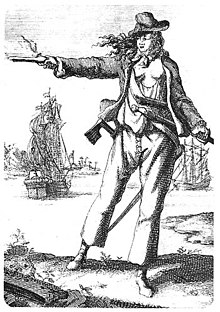
Bartholomew Roberts, born John Roberts, was a Welsh pirate who was, measured by vessels captured, the most successful pirate of the Golden Age of Piracy. During his piratical career, he took over 400 prize ships. Roberts raided ships off the Americas and the West African coast between 1719 and 1722; he is also noted for creating his own pirate code, and adopting an early variant of the Skull and Crossbones flag.

John Rackham, commonly known as Calico Jack, was an English pirate captain operating in the Bahamas and in Cuba during the early 18th century. His nickname was derived from the calico clothing that he wore, while Jack is a nickname for "John".

Mary Read, was an English pirate about whom there is very little factual documentation. She and Anne Bonny were among the few female pirates during the "Golden Age of Piracy".
Captain Charles Johnson was the British author of the 1724 book A General History of the Robberies and Murders of the most notorious Pyrates, whose identity remains a mystery. No record exists of a captain by this name, and "Captain Charles Johnson" is generally considered a pen name for one of London's writer-publishers. Some scholars have suggested that the author was actually Daniel Defoe, but this is disputed.
John Taylor, born Richard Taylor, was an English pirate active in the Indian Ocean, best known for participating in two of the richest pirate captures of all time.

Edward England was an Irish pirate. The ships he sailed on included the Pearl and later the Fancy, for which England exchanged the Pearl in 1720. His flag was the classic Jolly Roger — almost exactly as the one "Black Sam" Bellamy used — with a human skull above two crossed bones on a black background. Like Bellamy, England was known for his kindness and compassion as a leader, unlike many other pirates of the time.

The Golden Age of Piracy is a common designation for the period between the 1650s and the 1730s, when maritime piracy was a significant factor in the histories of the North Atlantic and Indian Oceans.

Charles Vane was an English pirate who operated in the Bahamas during the end of the Golden Age of Piracy.

A General History of the Robberies and Murders of the most notorious Pyrates, or simply A General History of the Pyrates, is a 1724 book published in Britain containing biographies of contemporary pirates, which was influential in shaping popular conceptions of pirates. Its author uses the name Captain Charles Johnson, generally considered a pen name for one of London's writer-publishers. The prime source for the biographies of many well-known pirates, the book gives an almost mythical status to the more colourful characters, and it is likely that the author used considerable artistic license in his accounts of pirate conversations. The book also contains the name of Jolly Roger, the pirate flag, and shows the skull and crossbones design.
Sir Nicholas Lawes was a British judge and colonial administrator who served as the governor of Jamaica from 1718 to 1722.
See also 1718 in piracy, 1720 in piracy, 1719 and Timeline of piracy.
See also 1719 in piracy, 1721 in piracy and Timeline of piracy.
True Caribbean Pirates is a documentary which aired on The History Channel in 2006.

The capture of John "Calico Jack" Rackham was a single-ship action fought between English pirate Calico Jack and British privateer Jonathan Barnet. The battle was fought in the vicinity of Negril, Jamaica and ended with the capture of Rackham and his crew.

The Republic of Pirates was the base and stronghold of a loose confederacy run by privateers-turned-pirates in Nassau on New Providence island in the Bahamas during the Golden Age of Piracy for about twelve years from 1706 until 1718. While it was not a republic in a formal sense, it was governed by an informal pirate code, which dictated that the crews of the Republic would vote on the leadership of their ships and treat other pirate crews with civility. The term comes from Colin Woodard's book of the same name.

The Flying Gang was an 18th-century group of pirates who established themselves in Nassau, New Providence in the Bahamas after the destruction of Port Royal in Jamaica. The gang consisted of the most notorious and cunning pirates of the time, and they terrorized and pillaged the Caribbean until the Royal Navy and infighting brought them to justice. They achieved great fame and wealth by raiding salvagers attempting to recover gold from the sunken Spanish treasure fleet. They established their own codes and governed themselves independent from any of the colonial powers of the time. Nassau was deemed the Republic of Pirates as it attracted many former privateers looking for work to its shores. The Governor of Bermuda stated that there were over 1,000 pirates in Nassau at that time and that they outnumbered the mere hundred inhabitants in the town.
Jean Bonadvis was a French pirate active in the Caribbean. He is best known for his involvement with Benjamin Hornigold and "Calico Jack" Rackham.
Daniel Porter was a pirate and trader active in the Caribbean. He is best known for his associations with Benjamin Hornigold and Bartholomew Roberts.

Jonathan Barnet was an English privateer in the Caribbean, best known for capturing pirates Calico Jack, Anne Bonny, and Mary Read. The Assembly of the Colony of Jamaica gave him a financial reward, and a large estate in the parish of St James worked by African slaves.

The Proclamation for Suppressing of Pirates was a royal proclamation issued by George I of Great Britain on 5 September 1717. It promised a pardon for acts of piracy committed before the following 5 January to those pirates who surrendered themselves to the correct authority before a deadline. Originally, the surrender had to occur on or before 5 September 1718; this was later extended by a second proclamation to 1 July 1719.














